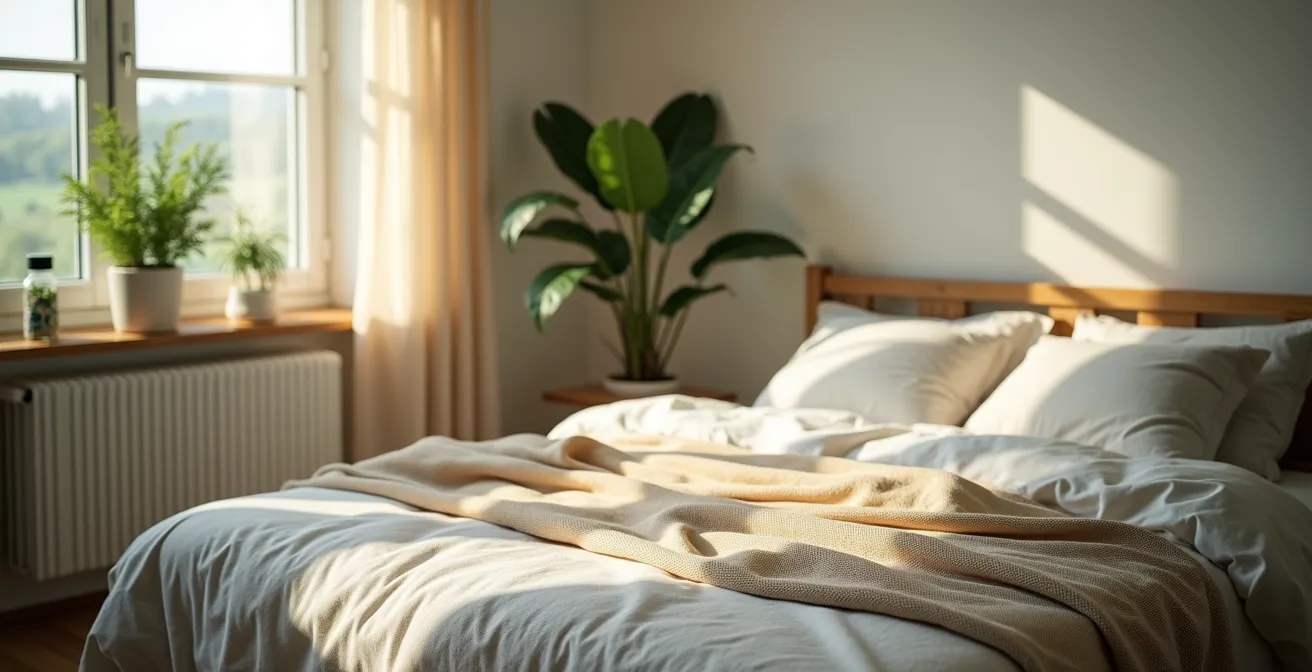
Achieving truly restorative sleep goes far beyond common advice like avoiding screens or drinking herbal tea. The reality is that sleep is not a passive state of shutdown but an active, complex biological process. It’s a precisely orchestrated event governed by an intricate network of systems within your body. Understanding this deep science is the key to unlocking profound improvements in your sleep quality and daytime vitality. A comprehensive approach, sometimes including a supplement like Novanuit Good Night Triple Action, can support these natural processes.
This journey into serenity moves past the superficial tips to explore the foundational pillars of sleep science: the microbial harmony in your gut, the subtle environmental cues in your bedroom, the precise choreography of your hormones, and the mastery of your body’s innate rhythms. By actively managing these elements, you can strategically enhance your body’s natural ability to rest and recover.
Your Blueprint for Scientific Sleep
Forget counting sheep. True sleep mastery involves understanding and optimizing four key scientific areas. This guide delves into the gut-brain axis for neurotransmitter balance, the environmental science of your bedroom’s air and acoustics, the hormonal interplay that dictates sleep cycles, and the personal chronobiology that governs your internal clock. By mastering these domains, you can transform your sleep from a nightly hope into a predictable, restorative experience.
The Gut-Brain Connection: Unlocking Sleep Through Microbial Harmony
The link between your digestive system and brain, known as the gut-brain axis, is a critical frontier in sleep science. Your gut is home to trillions of microorganisms that play a direct role in regulating your mood and sleep patterns by producing essential neurochemicals. A healthy, diverse microbiome is fundamental to synthesizing compounds like serotonin and gamma-aminobutyric acid (GABA), which are vital for promoting relaxation and initiating sleep.
What is the gut-brain axis?
The gut-brain axis is the two-way communication network between your gastrointestinal tract and your central nervous system. Gut microbes can produce neurotransmitters that send signals to the brain, directly influencing mood, stress, and sleep cycles.
Cultivating this internal ecosystem involves more than just diet; it’s about fostering a symbiotic relationship that supports brain health. The composition of your gut bacteria can either help or hinder your ability to achieve deep, restorative sleep.
Nurturing this environment with specific dietary patterns is crucial. Diets rich in prebiotic fiber from sources like artichokes, onions, and whole grains feed beneficial bacteria, helping them thrive. Conversely, diets high in processed foods and sugars can disrupt this balance, negatively impacting sleep quality.
The evidence for targeted interventions is growing. Research indicates a significant correlation between the presence of Lactobacillus and improved sleep parameters. These findings highlight how specific strains of bacteria can directly influence our ability to rest.
Effect of probiotics on sleep quality in adults
Illustrating this connection, a controlled trial showed a marked improvement in sleep latency (the time it takes to fall asleep) and overall sleep quality among participants. These benefits were observed after 4 weeks of daily prebiotic and probiotic supplementation, demonstrating a direct, actionable link between gut health and better rest.
Beyond Darkness and Quiet: Environmental Science for Deeper Sleep Architecture
While a dark, quiet room is a good starting point, the science of an optimal sleep environment goes much deeper. Subtle factors like ambient temperature, noise frequency, and air quality can profoundly influence your sleep architecture—the natural cycling through different sleep stages.
Temperature, for instance, is a powerful regulator of your internal clock. Your body temperature naturally drops to initiate sleep, and a cool room facilitates this process. Studies have identified an optimal bedroom temperature of 16-19°C linked to improved slow-wave sleep, the most physically restorative stage.

Creating a serene bedroom sanctuary, as depicted here, involves managing more than just aesthetics. Air quality is another critical, often overlooked, factor. Poor ventilation can lead to a buildup of carbon dioxide (CO2), which has been proven to disrupt sleep. Ensuring proper air circulation and maintaining ideal humidity levels (between 30-50%) can prevent respiratory irritation and promote easier breathing throughout the night.
Even sound plays a complex role. While sudden noises are disruptive, certain constant, low-frequency sounds can be beneficial.
Exposure to low-frequency ambient noise can enhance sleep regularity and reduce daytime sleepiness.
– Sleep Foundation Experts, Healthy Sleep Tips
Beyond these elements, the potential influence of electromagnetic fields (EMFs) from electronic devices is a subject of ongoing research, with some studies suggesting they may alter sleep patterns. Taking simple steps to mitigate exposure, such as keeping devices away from the bed, contributes to a more pristine sleep environment. To truly achieve more restful sleep, a holistic approach to your bedroom environment is essential.
Bedroom Optimization Checklist
- Set room temperature between 16-19°C.
- Use blackout curtains or an eye mask to block light.
- Employ white noise machines or earplugs if needed.
- Ensure air quality with ventilation and humidity control.
Hormonal Choreography and Nutritional Synergy: The Science of Sleep Timing and Composition
Sleep is regulated by a precise hormonal dance. Throughout the night, hormones like melatonin, cortisol, and growth hormone rise and fall in a carefully timed sequence to manage your sleep-wake cycle and facilitate physical recovery. When this rhythm is disrupted, sleep quality suffers.
Melatonin, the “sleep hormone,” signals to your body that it’s time to rest, while cortisol, the “stress hormone,” promotes alertness. In a healthy cycle, cortisol levels are lowest at night, allowing melatonin to dominate. Research confirms that elevated nighttime melatonin and reduced cortisol correlate with deeper sleep stages. This balance is crucial for restorative sleep.

This synergy between nutrition and hormonal balance is key to optimizing your internal clock. Your diet provides the essential building blocks for these hormones and the neurotransmitters that regulate them. Deficiencies in certain micronutrients can directly impair your ability to sleep soundly. As noted by the Endocrinology and Sleep Research Review, deficiencies in magnesium, iron, and B-vitamins are commonly linked to impaired sleep and restlessness. Addressing these nutritional gaps is a critical step toward hormonal harmony. You can explore nutrients for cognitive function to understand their broader impact.
The timing of your meals also matters. Consuming large meals, especially those high in fat, too close to bedtime can disrupt sleep architecture. Conversely, a strategically timed, carbohydrate-rich meal a few hours before bed may help shorten the time it takes to fall asleep for some individuals. Strategic nutrient timing can support the natural hormonal shifts that lead to a night of deep, uninterrupted rest.
Key Takeaways
- Your gut microbiome directly influences sleep quality by producing key neurotransmitters like serotonin and GABA.
- Optimizing your bedroom’s temperature, air quality, and ambient sound creates an ideal environment for restorative sleep.
- The balance between melatonin and cortisol is essential for regulating sleep-wake cycles and achieving deep sleep.
- Aligning your daily schedule with your natural chronotype can significantly reduce fatigue and improve overall well-being.
Navigating Modern Rhythms: Mastering Chronotypes and Mitigating Social Jetlag
Every individual has a unique internal clock, or chronotype, that dictates their natural preference for sleep and wake times. Whether you’re a “morning lark” or a “night owl,” this biological predisposition is a fundamental part of your physiology. Forcing your schedule to go against your natural rhythm can lead to chronic sleep debt and diminished daytime function.
Aligning sleep schedules with individual chronotypes can significantly improve cognitive performance and mood.
– Marc Wittmann et al., Social jetlag: misalignment of biological and social time
A common consequence of ignoring our chronotype is “social jetlag,” the discrepancy between our sleep schedule on workdays versus free days. This misalignment can have significant health consequences. Shockingly, studies show that social jetlag affects up to 70% of the population with an increased risk for metabolic and psychological disorders.

Mastering your personal rhythm is about more than just convenience; it’s a health imperative. The first step is to identify and honor your chronotype as much as possible. When your internal clock is disrupted by modern demands like travel or shift work, there are science-backed strategies to help you reset. Gradual schedule adjustments, strategic exposure to morning sunlight, and maintaining a consistent wake-up time even on weekends are powerful tools to anchor your circadian rhythm and mitigate the harmful effects of social jetlag.
Frequently Asked Questions on Sleep Improvement Strategies
What is a chronotype?
It is an individual’s natural preference for timing of sleep and activity, e.g., morning lark or night owl.
How can social jetlag be reduced?
By maintaining consistent sleep-wake times throughout the week and adjusting lifestyle factors influencing the biological clock.
What are the best foods to support sleep?
Foods rich in fiber and prebiotics, like vegetables and whole grains, nourish a healthy gut microbiome. Additionally, foods containing tryptophan, such as turkey and nuts, can support the production of serotonin and melatonin.
Can I change my chronotype?
While your core chronotype is largely genetic, you can shift it slightly over time with consistent sleep schedules, strategic light exposure, and lifestyle adjustments. However, it is generally more effective to work with your natural rhythm rather than against it.